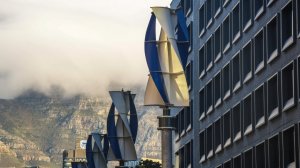Cape Town’s V&A Waterfront is pioneering the integration of small, low-noise vertical-axis wind turbines into its green electricity supply mix, following the installation of four 1-kW units within the mixed-use property’s Silo District and another 3-kW turbine near to the complex’s Breakwater parking.
The LS Double Helix turbines have been sourced from LuvSide, of Germany, which has in parallel established LuvSide South Africa in partnership with Energy Systems Africa to pursue new market opportunities for its vertical- and horizontal-axis solutions.
Through the pilot, which is also being supported by the German government’s Renewable Energy Solutions Programme, the turbines will be operated for a year.
Head of sustainability Petro Myburg says this will allow the V&A Waterfront to test the feasibility of scaling up the technology and incorporating the “aesthetically pleasing” turbines into its broader sustainability strategy.
Energy Systems Africa CEO Rodney Love tells Engineering News that the V&A Waterfront installation is also the first South African deployment for LuvSide, which has a portfolio of four turbine models and 50 units installed globally.
The pole-mounted vertical wind turbines operate using the Savonius design that, owing to the helix structure, the wind always hits no matter its direction. The LS Double Helix incorporates two main blades that are supplemented by slats to close gaps in the wind window and increase torque.
The electricity produced at the V&A Waterfront complements the facility’s existing solar PV installation and is fed into a 30-kW inverter that is also connected to a 45-kWh battery backup system.
Love says the energy contribution is based on the wind speed of an area and the capacity factor of the turbines deployed at the V&A Waterfront will be determined only once data from the pilot is collected.
He is convinced, however, that they will prove price competitive and that the South African market is poised to begin incorporating small wind turbines alongside solar as property managers and industrial enterprises, particularly those in the windy coastal regions, seek to further increase their green credentials and improve tariff certainty.
“We are already working with the City of Cape Town, the Atlantis Special Economic Zone, and Boardwalk mall in Port Elizabeth on further opportunities,” he reports.
Besides targeting other retail complexes and households with the LS Double Helix turbine, LuvSide South Africa is also marketing the larger and more efficient LS HuraKan horizontal-axis turbine to factories, mines and farms.
While not entirely noiseless, the 8-kW turbines incorporate a flexible-blade suspension that is able to change angle to improve yields and also reduce the diameter of the rotor to prevent any disengagement at high wind speeds.
“We see the solution as being particularly relevant to 24/7 operations with solar PV but that want to continue using renewable electricity at night,” Love says.
He is also optimistic that many of the components in both the horizontal-axis and vertical-axis turbines can be produced locally, noting that some local components were already successfully used for the initial installation and helped reduce the overall cost of the project.
“Currently the mast and base are being made locally for all turbines.
“But this is only the starting point, as we have competent local steel fabricators and using them will help offset high European labour rates and expensive travel costs.
“We’re also currently investigating the blades for local production and locally sourcing electrical components,” Love concludes.
Edited by: Creamer Media Reporter
EMAIL THIS ARTICLE SAVE THIS ARTICLE
ARTICLE ENQUIRY
To subscribe email subscriptions@creamermedia.co.za or click here
To advertise email advertising@creamermedia.co.za or click here












